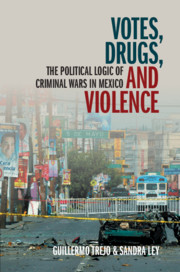Book contents
- Votes, Drugs, and Violence
- Cambridge Studies in Comparative Politics
- Votes, Drugs, and Violence
- Copyright page
- Contents
- Figures
- Maps
- Tables
- Preface
- Acronyms
- Introduction
- Part I A Political Theory of Criminal Violence
- Part II The Outbreak of Inter-Cartel Wars
- Part III The State’s War Against the Cartels
- Part IV The Rise of Criminal Governance: Subverting Local Democracy in War
- Appendix A Criminal Violence in Mexico Database (CVM)
- Appendix B Criminal Attacks Against Political Actors in Mexico (CAPAM) Database
- Appendix C Chapter 2. Multivariate Regression Models (Robustness Checks)
- Appendix D Chapter 4. Multivariate Regression Models (Robustness Checks)
- Appendix E Chapter 4. Natural Experiment (Additional Information)
- Appendix F Chapter 6. Multivariate Regression Models (Robustness Checks)
- Appendix G Chapter 6. Natural Experiments (Additional Information)
- References
- Index
- Other Books in the Series (continued from page iii)
Introduction
Published online by Cambridge University Press: 16 September 2020
- Votes, Drugs, and Violence
- Cambridge Studies in Comparative Politics
- Votes, Drugs, and Violence
- Copyright page
- Contents
- Figures
- Maps
- Tables
- Preface
- Acronyms
- Introduction
- Part I A Political Theory of Criminal Violence
- Part II The Outbreak of Inter-Cartel Wars
- Part III The State’s War Against the Cartels
- Part IV The Rise of Criminal Governance: Subverting Local Democracy in War
- Appendix A Criminal Violence in Mexico Database (CVM)
- Appendix B Criminal Attacks Against Political Actors in Mexico (CAPAM) Database
- Appendix C Chapter 2. Multivariate Regression Models (Robustness Checks)
- Appendix D Chapter 4. Multivariate Regression Models (Robustness Checks)
- Appendix E Chapter 4. Natural Experiment (Additional Information)
- Appendix F Chapter 6. Multivariate Regression Models (Robustness Checks)
- Appendix G Chapter 6. Natural Experiments (Additional Information)
- References
- Index
- Other Books in the Series (continued from page iii)
Summary
One of the most surprising developments in Mexico’s transition from authoritarian rule to democracy is the outbreak of criminal wars and large-scale criminal violence after the demise of seven decades of one-party rule. Under the reign of the Institutional Revolutionary Party (PRI), several major drug cartels had coexisted in relative peace and pursued their criminal activities without conflict among themselves or serious confrontation with the state. But as the country moved into multiparty competition and opposition parties scored unprecedented victories across cities and states in the 1990s, eventually winning presidential power in 2000, the cartels went to bloody war over profitable drug trafficking routes. As the late journalist Jesús Blancornelas (2002) observed, the first major inter-cartel war emblematically broke out in Tijuana in the northwestern state of Baja California where, in a historic 1989 election, the PRI had lost control of a state for the first time in the century.
- Type
- Chapter
- Information
- Votes, Drugs, and ViolenceThe Political Logic of Criminal Wars in Mexico, pp. 1 - 28Publisher: Cambridge University PressPrint publication year: 2020

